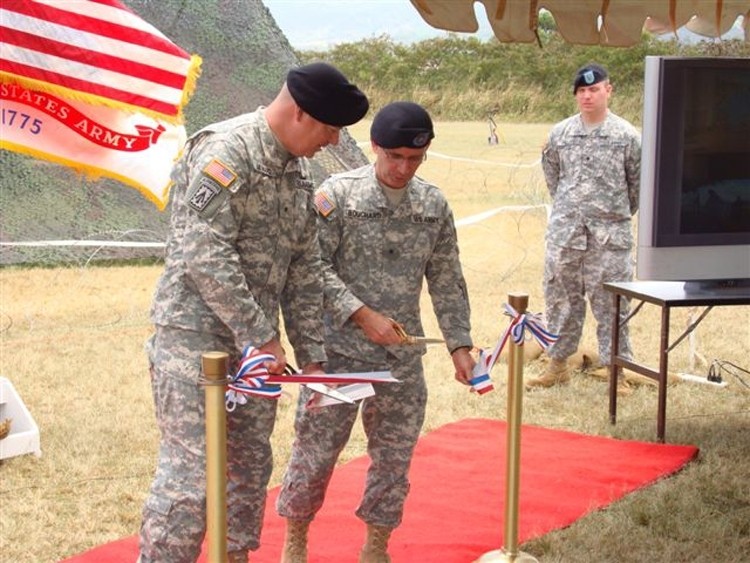
SCHOFFIELD BARRACKS, Hawaii - "In 1900, Admiral Alfred T. Mahan, one of the great American military strategists, said: 'communications dominate the war; broadly considered, they are the most important single element in strategy, political or military.' Admiral Mahan's statement is even more relevant today," said Brig. Gen. John E. Seward during a ribbon cutting ceremony that marked the beginning of a new era for satellite communications.
On May 1, Seward, deputy commanding general for operations, U.S. Army Space and Missile Defense Command/Army Forces Strategic Command (SMDC/ARSTRAT), and Brig. Gen. Ronald M. Bouchard, director, J-6, U.S. Pacific Command, took part in a monumental occasion that celebrated the official activation of the first Wideband Global SATCOM (WGS). The WGS-1 launched aboard an Air Force Evolved Expendable Launch Vehicle from Cape Canaveral, Fla., Oct. 11, 2007. After six months of extensive testing, WGS-1 successfully activated on Apr. 14, 2008, and on Apr. 15, users were transitioned from DSCS B9 to WGS-1. The ribbon cutting ceremony symbolized the activation of WGS-1, which is now providing invaluable communications capabilities to the warfighter.
Gen. Kevin Chilton, commander, U.S. Strategic Command, accepted Combatant Command of WGS-1 by signing the WGS-1 COCOM acceptance memorandum on Apr. 11, 2008. This set in motion the activation of WGS-1, according to Lt. Col. Michael Perry, chief, SATCOM Support Center (SSC) Branch. The activation of WGS-1, which provides coverage over the Pacific theater, was no easy task.
"This required tremendous coordination and timing from many organizations from Washington, D.C., to Korea," said Bouchard. "A couple of stumbling blocks appeared at the last minute, but we prevailed and we now have an operational satellite servicing the U.S. Pacific Command Area of Responsibility.
"This region is often characterized by the tyranny of distance. It comprises more than 50 percent of earth's surface; from the west coast of the United States mainland to the east coast of Africa, from the Arctic to Antarctic. Most of the area of responsibility is blue water where it's very difficult to plug into the information highway. So satellite communications is crucial for U.S. Pacific Command forces. The WGS-1 satellite provides incredible communications capacity for the U.S. maritime forces as well as the ground troops deployed."
The activated satellite is the first of six WGS satellites which will transform the Department of Defense's communications architecture to support future warfighting technologies. Over the next five years, the additional five WGS satellites will be launched, providing worldwide communications coverage.
Each of the WGS satellites will supply more than 10 times the capacity of a Defense Satellite Communication System (DSCS) satellite. The WGS constellation will augment and eventually replace DSCS, which has been servicing the Department of Defense Satellite Communication needs since 1982. The last DSCS satellite launched in 2003.
"As you may know, the expected life of a satellite is only 10 years, so we have been operating on borrowed time," said Bouchard.
"The development and launching of this satellite was the culmination of a 10-year cooperative effort between Boeing, the U.S. Air Force Space Command, U.S. Strategic Command; and U.S. Army Space and Missile Defense Command/Army Forces Strategic Command," added Seward.
"Members of this command have been involved in the WGS program from the very beginning -- a briefing in 1997 to a Senior Warfighters Forum -- developing the requirements for the system, testing the system, and culminating in its launch on Oct. 10, 2007."
WGS combines distinctive commercial spacecraft capabilities developed by Boeing, according to Perry. The design includes 19 independent coverage areas, including eight steerable and shapeable X-band beams formed by separate transmit and receive phased arrays; 10 steerable Ka-band beams served by independently steerable, diplexed gimbaled dish antennas, including three with selectable polarization; and one X-band Earth coverage beam. The onboard digital channelizer divides the uplink bandwidth into more than 1500 independently routable 2.6MHz subchannels. This provides any coverage to any coverage including crossbanding. The system will provide much needed capacity, coverage, connectivity, and control to the warfighter.
For now, as far as the PACOM theater is concerned, "WGS will enable USPACOM to meet its mission, in concert with other U.S. government agencies and regional military partners such as our long-time ally, Australia, to promote security and peaceful development in the Asia-Pacific region by deterring aggression, advancing regional security cooperation, responding to crises, and fighting to win," added Bouchard.
Concluded Seward: "Ten years in development - a long time; 10 times the capacity - a large increase. And why' Today, as in Admiral Mahan's time, the ability to communicate dominates warfighting."

Social Sharing